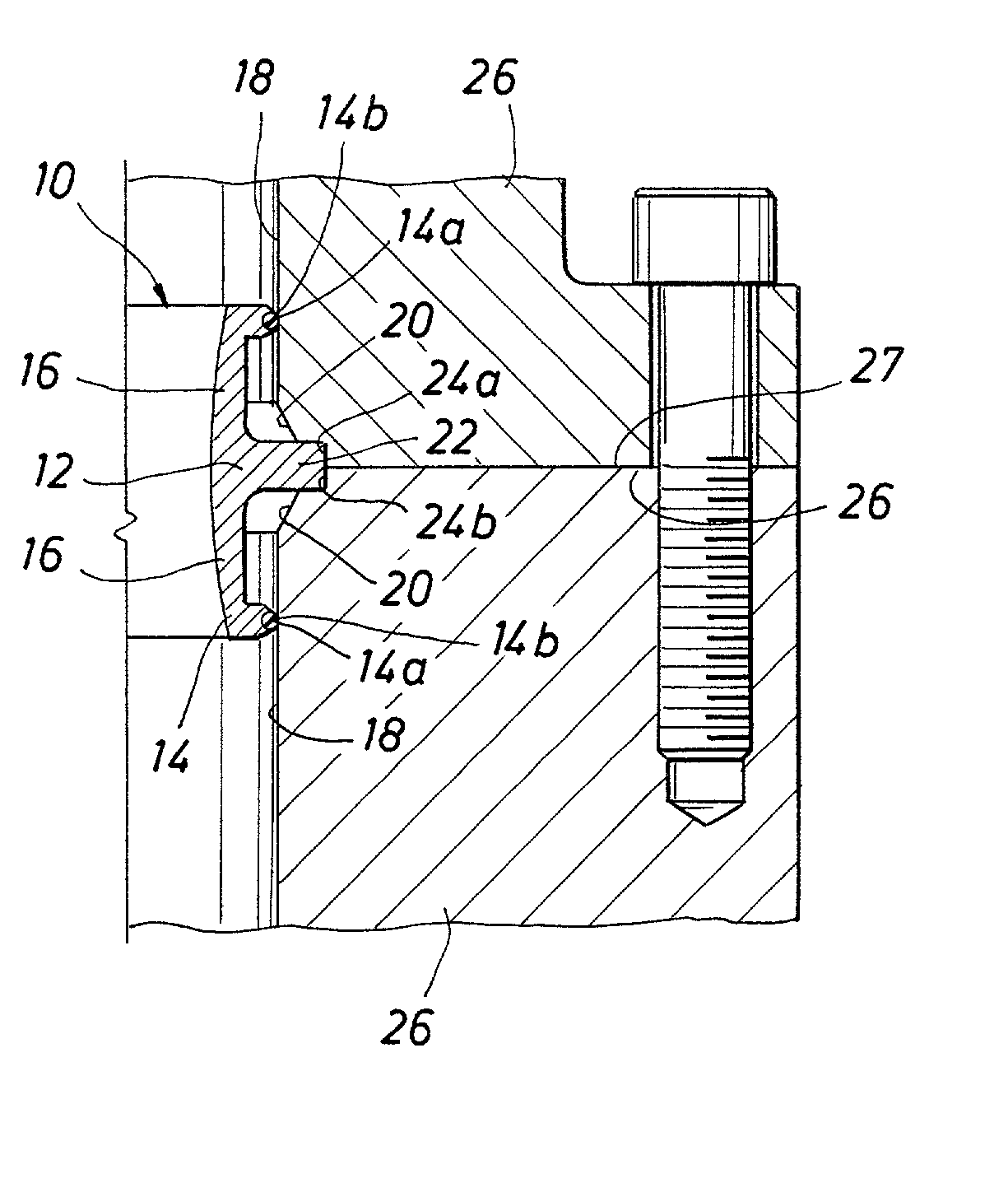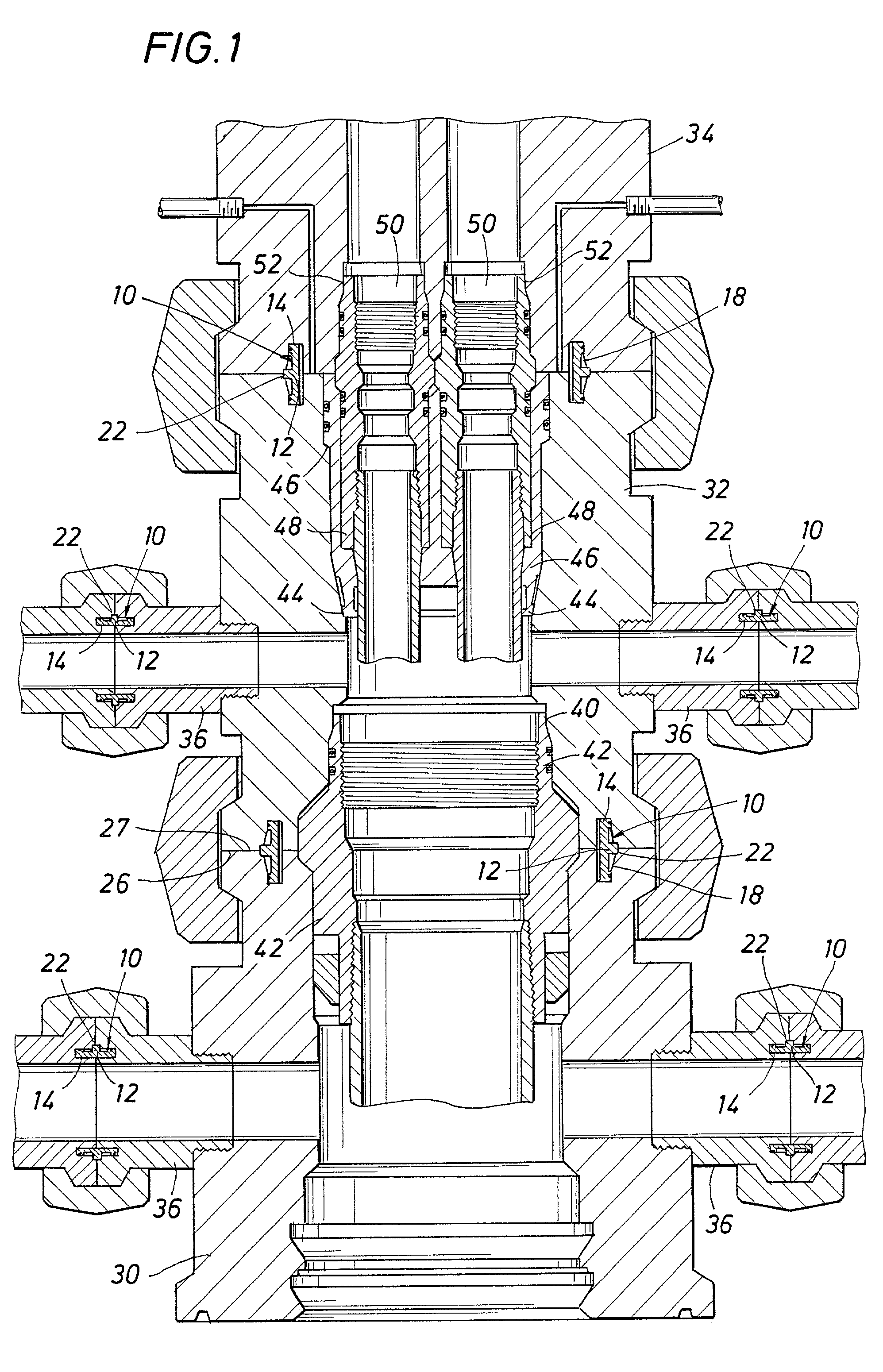[0006] A primary object of this invention is to provide a high performance and low cost metal-to-metal sealing assembly for use in
high pressure seal applications including straight bore metal seal (SBMS) of the nature set forth in U.S. Pat. No. 4,471,965 and further capable of being employed as rough casing metal seals (RCMS), FX bonnet gaskets, RX, BX, AX and other currently used metal-to-metal seal designs.
[0007] A novel concept for high-pressure, metal-to-metal sealing which employs a high strength metal seal body or carrier which facilitates application of spring energy or preload force to a soft
metal insert carried by the seal body to accomplish
high pressure metal-to-metal sealing even under conditions of poor
surface finish or irregular sealing
surface geometry. The present invention has application to rigid metal-to-metal seal technology including Straight Bore
Metal Seals, FX Bonnet
Gasket Seals, RX, BX, AX gaskets and others. The present invention represents an improvement to the
High Pressure Fire Resistant Seal set forth in U.S. Pat. No. 4,471,965. The concept of the invention involves separating the
structural element (body) from the sealing element (soft metal circumferential insert). Seal designs using this technology employ one or more soft metal inserts that are installed by pressing, shrinking or other retention mechanisms on a higher strength seal body or carrier. The higher strength seal body elastically deforms and provides a spring energy characteristic to activate the seal, plastically deforming the soft metal circumferential seal insert when installed. The high strength seal body also confines and protects the soft metal circumferential sealing element against pressure and mechanical abuse. This type of seal increases contact area, allows lower
alloy materials (such as 410 stainless steel, 8630, or 4130 steel) to be used for the body of the seal, prevents
galling, and also allows the soft metal seal inserts to be replaced, thus enabling reuse of seal bodies. The soft metal circumferential insert will also allow wider
machining tolerances, and seal against surfaces that have defects, such as scratches. This seal design may also be tolerant to slightly oval shaped seal bores. The sealing concept of the present invention represents an improvement over metal seals that simply have a soft
coating on the surface or require the soft metal to be welded to the high strength component. Coatings have limited wear / corrosion life and cannot fill large defects in the sealing area.
Welding the soft metal to the high strength component adds complexity, expense, and limits
material selection and may preclude reuse of the seal.
[0008] Current high pressure metal sealing technology, such as Straight Bore Metals Seals (SBMS, described in U.S. Pat. No. 4,471,965), Rough Casing
Metal Seals, FX Bonnet gaskets, RX, BX and AX seals require higher strength alloys to provide sealing force and
structural integrity. These types of seals are widely used in
gate valve bonnets, surface and
subsea connectors, flow bores and generally throughout a wide range of
wellhead equipment for the
petroleum industry. The strength requirements of these alloys can be up to 120,000 psi yield. These seals function by plastically deforming a small annular area of a seal element or projection into a smooth opposing annular sealing surface. The seal contact area is generally small, and these seals are generally (with a few exceptions), not reusable. Often, due to corrosion requirements, high strength
corrosion resistant alloys (CRAS) are selected for these seals, thus causing the seals to be of considerable expense. Especially if the seals can only be installed once and then discarded, the
impact of seals cost is significant. Using higher strength body of a less expensive material, with a soft
metal insert made from a more
corrosion resistant material, will improve performance and reduce costs in metal-to-metal sealing. In addition to being reusable, the soft
metal insert will allow interacting seal components to have wider
machining tolerances, enabling sealing against sealing surfaces that have defects, such as scratches or poor finish. Currently technology requires that the sealing surfaces be of 32 microinch RMS quality or better. The soft metal seal inserts of the present invention will function efficiently even when the
surface finish of the sealing surfaces is of less than that being typically required at the present time.
 Login to View More
Login to View More  Login to View More
Login to View More 


